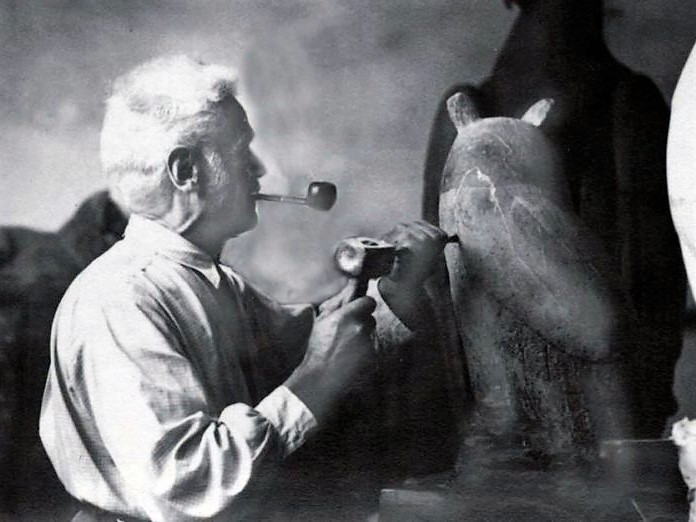Wilhelm Krieger was the son of the painter Eduard Theodor Krieger. He was born on the East Frisian island of Norderney in the North Sea. He soon left the island and lived as a pupil with relatives in Norden, where he attended the gymnasium. However, he spent most of his life in Munich and the nearby town of Herrsching am Ammersee.
He left Norden without completing his studies and began a three-year apprenticeship as a decorative painter in Bremen. He left for Munich in 1896 without completing this apprenticeship. There, he enrolled at the Kunstgewerbeschule 1896/1897, but dropped out after one semester. He returned to painting and became a member of the Vereinigte Werkstätten München (a movement similar to the Arts and Crafts movement in Great Britain and the Vienna Secession). From 1901 onwards, Krieger learnt to sculpt and became familiar with bronze casting and the art of patination. Two years later, he became a partner in the Munich firm Zierhut & Krieger, which supplied arts and crafts items such as tableware and jewelry. He began to devote himself to animal sculpture and began freelancing for the Keramische Werkstätten in Herrsching, where he later met his future wife, Emilie Butters, a ceramist and art teacher.
In 1907, he became a member of the Munich Secession. This enabled him to present sculptures at exhibitions organized by the Munich Secession. It also enabled him to exhibit his work in the following years in Berlin, Bremen, Dresden, Düsseldorf and London.
In 1912, Krieger married Emilie Butters, then artistic director of the painting department at the Herrsching ceramics workshops. The couple had five children. In 1927, Wilhelm Krieger was awarded the honorary title of Professor by the Bavarian Ministry of Culture. Wilhelm Krieger's first solo exhibition took place in 1934 at the Städtische Galerie in Nuremberg, and was acclaimed by contemporaries. From 1937 to 1944, Krieger participated in the major annual exhibition of German art at the Haus der Kunst, organized in Munich at the instigation of Adolf Hitler. The Haus der Kunst was to present what the National Socialists considered to be “true” German art. Yet there is nothing “National Socialist” about Krieger's art.
Krieger, hard of hearing since childhood, relied on the power of his pictorial abilities. It was not speech or writing, but sculpture that enabled him to express himself. As a child, Wilhelm Krieger was very attached to the animals of his homeland, which he met on his daily walks. His sculptures mainly depict German mammals and often birds: owls, ducks, jackdaws, roosters, falcons, buzzards, eagles, condors, cranes or marabouts populated his studio, alongside other domestic animals such as cats, dogs, deer and sometimes monkeys. Krieger's contemporaries praised his sculptures for their purity of form and admired his ability to strongly stylize animals while capturing their naturalism. Krieger, a self-taught sculptor, created highly individual works of art that reflect his unique personal vision. He was interested in modeling animals without loading them with any symbolic meaning. Krieger has neither studied nor been influenced by other animal sculptors. Through stylization and simplification, Krieger has created vivid sculptures which, although very different, sometimes have, due to their softness, smoothness and austerity, an intensity somewhat similar to that of the work of French sculptor François Pompon.
Unlike the porcelain sculptures, which were mass-produced by model-makers in porcelain factories far from the artist's home, it is the bronzes that show Krieger's great craftsmanship and skill. He did not miss the opportunity to chisel the surfaces of the bronzes himself, to give the sculptures the final touch and surface color. Experts praise the unusual, warm color and finely detailed, elaborate surface treatment of Krieger's works.
Krieger's works have already found their way into major museums and collections, and Wilhelm Krieger will certainly also receive his rightful place in the ranks of the great German animal sculptors such as August Gaul and Fritz Behn in the near future.

